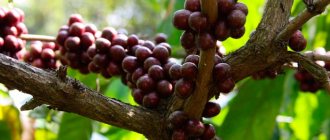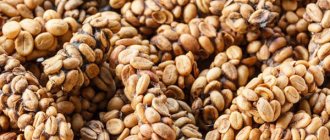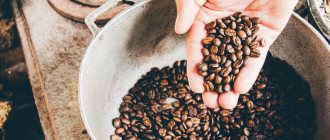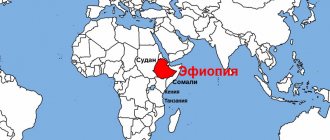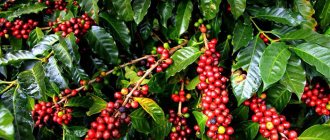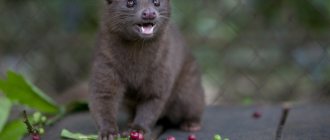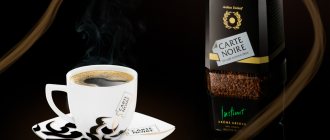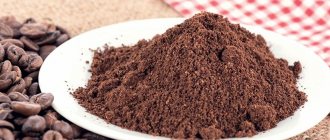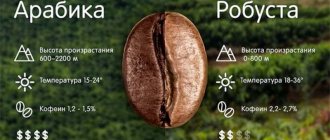Types of coffee
Add a comment
Good day, readers of our site! What do we know about a country like Colombia? Probably quite a bit, but true coffee lovers know that the best coffee grows here. In order to grow excellent coffee, Colombians do not spend much effort, since there is a wonderful climate that suits coffee trees perfectly. Colombian coffee is known to all gourmets who prefer this drink at any time of the day.
Almost half of Colombia's residents work on coffee plantations, which allows them to grow and harvest the best coffee beans. In terms of popularity, coffee varieties from Colombia are second only to Brazil and Vietnam.
Coffee plantations appeared in Colombia in the 17th century. After a while, only in 19, coffee beans began to be processed en masse and a special enterprise was opened that grew the grain and then exported it abroad in large quantities.
Another century later, in the 20th century, Colombian coffee became very popular due to its excellent taste, rich and deep aroma. All this becomes possible thanks to the suitable climate and composition of the soil in which the coffee trees grow.
We recommend drinking this drink from the Czech Leander porcelain set
Quality - Colombia!
The best coffee in the world is Colombian coffee. This is due to the unsurpassed quality of coffee beans.
Because Colombia has a wonderful climate and different coffee growing regions, we have such a wide selection of different varieties.
It is worth noting that Colombian coffee has an incredibly strong aroma and mild taste. Depending on the region, coffee beans will taste different.
Those varieties that were grown at the foot of the volcano will have a more tart taste. They are usually used to make espresso or tinto, as black coffee is also called in Colombia.
Personally, I like to buy cappuccino based on the strongest variety.
Many people know that Arabica coffee is considered the best coffee in the world. And here it is very important to note that Colombia produces and supplies only 100% Arabica beans and this is another indicator of the quality of the product.
What is the best coffee beans, I think we figured it out.
Characteristics
In each region of Colombia, coffee is made slightly differently, so it is difficult to identify a single flavor profile. However, in almost any brand you can distinguish floral tones, tropical flavors, red berries, apples, sweetish notes of chocolate, sugar cane or caramel.
The popularity of Colombian coffee on the international market is not least due to its softness: such beans blend well with other varieties, creating a harmonious and deep aroma.
Colombian-grown beans can be roasted intensely without becoming overly bitter. Most often they are used for espresso and coffee cocktails based on it.
World leaders
There are several leading coffee producing and exporting countries around the world.
The largest producer is Brazil. In second place is Vietnam, and only then comes Colombia. Despite the third place, Colombian coffee is especially appreciated throughout the world.
The country earned its quality mark thanks to the production of 100% Arabica, which has an excellent taste and aroma.
Therefore, the cost of Colombian coffee may be several times different from the larger suppliers that I wrote about above.
How to brew a drink correctly
Properly brewed Colombian coffee always receives rave reviews. Connoisseurs and lovers appreciate the drink for its balanced taste, richness and incredible aroma.
The grains should be ground finely and immediately before preparing the drink. Pour a heaping teaspoon of ground product into a preheated Turk. Pour 200 ml of cold water there. Keep over high heat until it starts to boil (the first bubbles should appear on the surface), immediately remove the Turk from the heat. Repeat the procedure 2-3 more times with an interval of 30 seconds.
Important! The drink should not boil during preparation, otherwise the real taste of Colombian coffee will be lost.
Rinse the cup with boiling water and pour the finished drink in a thin stream. Sweeten to taste with cane (brown) sugar.
Juan Valdez
It should be mentioned that Colombia has its own national coffee brand - Juan Valdez . This is the name of a fictional character, a coffee farmer.
My favorite cappuccino Juan Valdez
In 1959, the Federation of Colombian Coffee Producers decided to increase the recognition of its main product on the world market. And Juan Valdez became the face of the company, which quickly gained popularity.
Think you've never heard of this brand before? Then remember the movie “Bruce Almighty”, namely the moment when Jim Carrey orders coffee to cheer himself up. And then he appears, Juan Valdez:
The Colombian product has always been distinguished by its quality compared to neighboring Brazil. It should be noted that farmers strictly monitor the coffee preparation process and try to improve the quality of the product.
Due to quite a lot of competition in the country in this area of agriculture, farmers literally compete for first place in the quality of their product.
Therefore, very often small productions have excellent quality. But this coffee almost always remains within the country.
Another reason to visit Colombia, don’t you think?
Almost every second family has its own coffee plantation. This is a very popular business in Colombia.
Brief introduction
Colombian coffee is a product made from beans from coffee trees grown in Colombia, a country in northwestern South America. This is where truly wonderful coffee is grown. The following factors contribute to this:
- The special humid climate in the mountainous regions of the country is ideal for coffee trees.
- Historically established traditions of plantation cultivation, passed down from generation to generation, thanks to which the secrets of agricultural technology are not available to outsiders.
- Improved varieties of coffee trees. A lot of attention is paid to this issue in the country, because this industry accounts for 4.7% of Colombia's GDP and provides jobs for a third of the population. Some unique plantations are protected by UNESCO.
The trade brand “Colombian Coffee” is prohibited by the laws of the country and the European Union to be used in relation to coffee grown outside the republic.
Product Features
- Coffee tastes different depending on the region, so pay close attention to where it was harvested. This way you can choose different types of beans and have a real tasting at home.
- The total area of coffee plantations is more than 9,400 square km
- The coffee triangle is a large part in the center of the country where the main crop is harvested. It is there that you can take one of the excursions and study the entire production process
- The temperature in the Coffee Triangle ranges from 8-24 degrees
- Some plantations are located almost 2000 m above sea level
- Plantations occupy 20% of the country
- Previously, Colombia was second in the world ranking of producers, but now it has dropped to a lower position due to global warming. As a result, some regions have become unsuitable for growing coffee.
Types and varieties of Colombian coffee
Colombia produces exclusively Arabica beans. The three main types of coffee in Colombia are named after the cities of production: Medellin (and its more expensive variation, Medellin Supremo), Armenia and Manizales. All of them grow in the central region, often even referred to by the common acronym MAM. This type of coffee has increased acidity compared to varieties grown to the east.
The higher the area above sea level, the higher the quality of the coffee.
The Castillo variety evokes quite controversial feelings. This is an Arabica, but is genetically related to Robusta. Accordingly, the variety resists diseases well (for example, “rust” on the leaves), but its quality raises doubts among some tasters.
The autochthonous Brazilian variety Caturra is one of the best offerings on the Colombian coffee market. It makes a light-bodied, refreshing drink. Finally, the Tinto style is quite popular - it is inexpensive and tasty coffee, although not stunning, but of quite decent quality.
Grain processing
In Colombia, as in other countries, the most common method for processing grains is mainly used. When the crop is harvested, everything unnecessary is removed from the fruits of the coffee tree: leaves and twigs, and then the skin and pulp. After this, the grains are left to dry in the sun. The equatorial sun completes the processing process.
Today there are not many large industries in the country that use the more modern and expensive wet processing method. In this case, the berries are fermented and not dried in the sun, which, in theory, preserves a richer taste and aroma.
Most of the producers are mainly small farms, operate according to the old method and preserve the traditions as they were 100 years ago.
Preparation
There are several ways to roast coffee. Depending on the intensity, the drink acquires its unique taste.
When roasted lightly, the drink seems sweeter, it contains notes of caramel and citrus. When strong, the taste becomes more rich and tart, but due to the high quality of the berries themselves, the coffee does not become bitter.
How do Colombians prepare coffee?
- In the coffee machine. Arabica is ideal for espresso, cappuccino, etc.
- In the aero press. Quite a popular method. Every year in Bogota they hold competitions to prepare the drink in this way.
- Traditionally - in a coffee maker on the stove.
- They brew instant coffee, which is not inferior in quality to grain coffee.
Range
The tables present companies occupying the main segments of the coffee market.
| Coffee market segments/Companies | ||
| Green | Naturally roasted and ground | Soluble |
| Bernard Rhodes | Russian product | Nestlé (Nescafe) |
| Orimi trade | Chibo | Chibo |
| Orimi trade | Kraft Foods (Maxwell House and Jacobs) | |
| Kraft Foods | Russian product | |
| Kappa | Grandee | |
| Moscow coffee shop on shares | Moscow coffee shop on shares (Arabica and Colombo) | |
| Bowling | NEP (Jockey, Jardine) | |
| Golden Domes (Black Card brand) | Seda International (Ambassador brand) | |
| Golden Domes (Black Card brand) |
Beans and ground coffee are mainly Arabica, less commonly a mixture of Arabica and Robusta. Bean coffee is found in large supermarkets and small specialty shops. Retail outlets that sell “a little bit of everything” usually offer instant coffee. Sales ratio in the instant coffee segment
The leading companies that divided the instant coffee market are presented in the diagram
| Manufacturer | Product type | Advantages | Price range |
| Grand Classic, Brazil | spray, no artificial flavors, | Pleasant taste and aroma | LOW (relatively low price) |
| Grand Classic, Brazil | Ground, Arabica quality, unflavored | Pleasant taste and aroma | LOW (relatively low price) |
| Golden Domes (Black Card) | Cereal, ground, instant | Pleasant taste and aroma | LOW (relatively low price) |
| NEP (Jockey, Jardine) | Cereal, ground, instant | Pleasant taste and aroma | LOW (relatively low price) |
| Kraft Foods | Instant, ground, grain (Arabica) under the Jacobs and Maxwell House brand | The aroma is preserved using special packaging | Moderate (average price range) |
| Nestle | The products are sold under the Nescafe brand: in the form of sublimate, granules, capsules, ground coffee | Has a pleasant, delicate taste | Moderate (average price range) |
| Thcibo (Chibo) | Ground and beans. There are 5 main varieties of coffee on the market: Espresso (Milano Style, Sicilia Style), Golden Collection, Exclusive and Mild (high quality Arabica) | Rich aroma, rich taste | Moderate (average price range) |
| Live coffee | Ground and beans (Mocha, Espresso, Bourbon), high quality Arabica | Moderate (average price range) | |
| Lavazza, Italy | Ground, grain, Arabica | Considered one of the best brands | Moderate (average price range) |
| Moscow coffee shop on shares | Grain, Arabica | Moderate (average price range) | |
| Italy Bianca | Grain (Arabica, Robusta) | Soft rich taste, thick foam | Moderate (average price range |
| Seda International (Ambassador) | Cereal, instant, ground | Moderate (average price range | |
| Coffee Yemen Mocha Matari | Grain, Arabica | Spicy chocolate taste with a fruity aftertaste | Premium |
| Coffee Blues Australia Skybury | Grain, Arabica (ribbed variety) | Subtle aroma, rich taste with notes of flowers, spices and dark chocolate | Premium |
